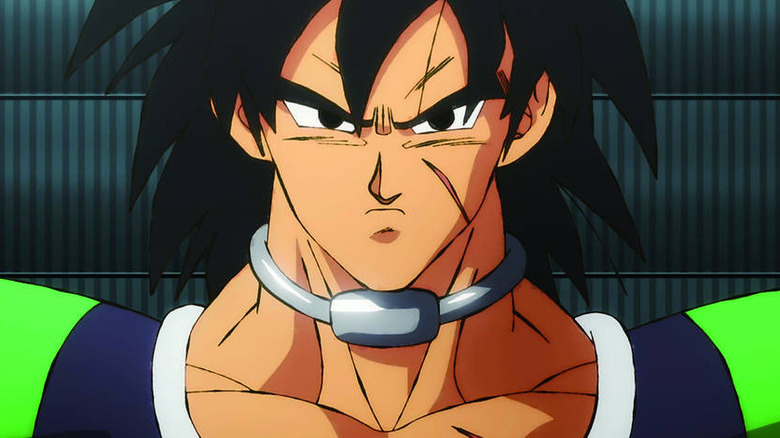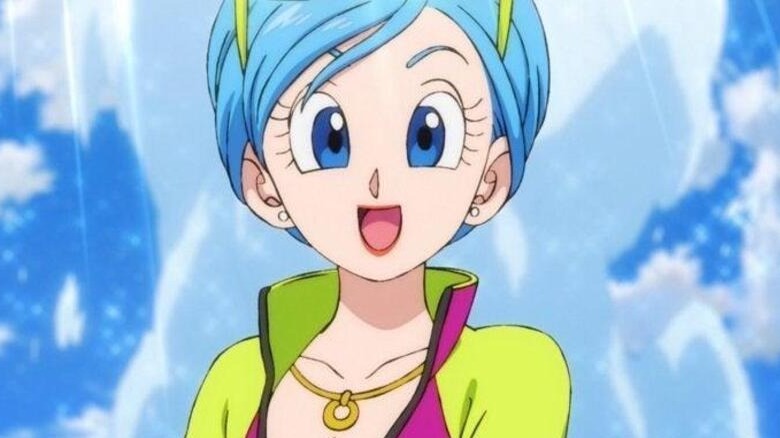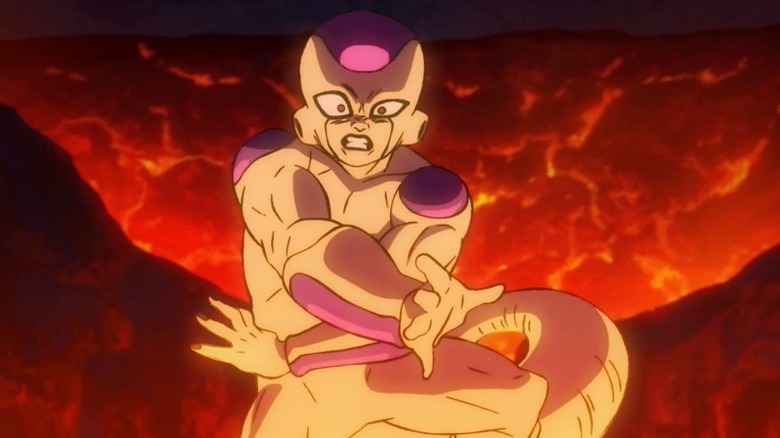The Untold Truth Of Dragon Ball Super: Broly
One of the most iconic manga franchises of all time is "Dragon Ball," created by Akira Toriyama and adapted into multiple anime series and movies, video games, and more. The 2018 anime film "Dragon Ball Super: Broly" served as a continuation of the revival series "Dragon Ball Super," reintroducing Broly as a more sympathetic antagonist after prior non-canonical appearances in the franchise. Manipulated by the villainous Frieza to fight Vegeta and Goku, the two longtime frenemies will have to work closer than ever to take down the rampaging Legendary Super Saiyan.
An enormous critical and commercial success, "Broly" was praised for its engaging fight sequences, more nuanced depiction of Broly, and kinetic art style and proved there is still plenty of life in the long-running franchise. Here are all the behind-the-scenes secrets during the production of "Broly," from director Tatsuya Nagamine's influences and inspirations in helming the movie to input from Toriyama himself beyond his role as the film's screenwriter.
Akira Toriyama's original screenplay ran for nearly twice as long
Like the two preceding "Dragon Ball Z" films, 2013's "Battle of Gods" and 2015's "Resurrection 'F,'" "Broly" is written by "Dragon Ball" creator Akira Toriyama. Toriyama had grand plans for the 2018 film, turning in a large screenplay to Nagamine and the rest of the production team. In an interview with the official "Dragon Ball" site, Nagamine reveals that, after storyboarding Toriyama's original script, the movie was projected to run for twice the intended length.
"Broly" was planned to run for approximately 90 minutes, with Nagamine feeling that the script Toriyama had written was enough to cover two feature films. Nagamine worked closely with the producer and the rest of the production crew to trim down Toriyama's script to a more manageable runtime while retaining the "Dragon Ball" creator's vision. Nagamine successfully extended the runtime to 100 minutes to allow for as much of Toriyama's original story for "Broly" as possible.
Broly was crafted by several One Piece veteran animators
Nagamine has been a prominent animator and filmmaker with Toei Animation for years, working not only on "Dragon Ball Super," but also on the long-running "One Piece" anime series and several of its films. With "Broly" possessing its own animation style, Nagamine recruited two of his prior collaborators from the 2012 anime film "One Piece Film: Z" to work with him on the "Dragon Ball Super" project. In the "Dragon Ball" official site interview, Nagamine cites both background animator Nobuhito Sue and animation director Naohiro Shintani as prominent past "One Piece" colleagues he brought on to work with him for "Broly."
While the animation team brought their own visual flair to the production, they were keenly aware that iconic imagery such as Super Saiyan transformations and Kamehameha Waves were firmly established in fan expectations. Nagamine instructed the animators to feel free to use modern technology rather than rely entirely on traditional methods to bring the movie to life. Nagamine reasons that just as Goku evolves and grows over the course of "Dragon Ball," so too should the visuals behind the franchise.
Nagamine only spoke directly with Toriyama once
Though Toriyama wrote the screenplay for "Broly" and provided character designs for the film, including a redesigned look for the eponymous Legendary Super Saiyan, his contact with the production crew was limited. In fact, the "Dragon Ball" creator only spoke directly with Nagamine on a single occasion during the entire production of the film. According to the printed theatrical program for "Broly" distributed with the Japanese release of the film, Nagamine spoke with Toriyama during a private advance screening for the film's staff.
Nagamine admitted he did not consult with Toriyama before starting production on "Broly," feeling he had Toriyama's tacit blessing to do the provided script justice. Prior to "Broly," Nagamine adapted Toriyama's work with the "Dragon Ball Super" anime series and the 2007 short film "Doctor Slump: Dr. Mashirito & Abale-chan." Nagamine felt that these experiences helped him understand Toriyama's storytelling nuances and stylistic sensibilities and kept them in mind during production.
Even more ambitious fight scenes were planned
With the battle against Broly lasting for most of the film, the clash begins in an arctic location by Frieza's spaceship on Earth before the snowy environment is completely destroyed. The fighting only intensifies, however, with exposed magma burning below the combatants before the volatility of the skirmish begins to shatter the walls to reality. Though this changes up the visual aesthetics of the movie's environments and the fight itself, Nagamine had even more ambitious plans for the film's climactic bout.
In the theatrical program for "Broly's" wide release in Japan, Nagamine reveals he had considered having the fight progress into outer space near the Earth's sun or deeper within the planet's core. In addition to changing up the scale of the battle, the settings would be a clear homage to similarly set sequences in the non-canonical anime film "Dragon Ball Z: Broly – Second Coming." However, these plans were dropped to accommodate the final film's 100-minute runtime, keeping the conflict largely on terra firma, apart from a brief dimensional hop.
Nagamine left the Dragon Ball Super anime for the movie
Nagamine is a credited co-director on the anime series "Dragon Ball Super" for the latter half of its run, from episodes 78-131, working with fellow co-director Ryota Nakamura. While the last stretch of episodes was produced concurrently with "Broly," Nagamine intended to maintain his full directorial responsibilities, helming both projects simultaneously to see "Dragon Ball Super” through to the end. Nagamine's intentions were overruled by Toei Animation, however, who had him instead focus his primary efforts on directing "Broly" rather than the television series.
In an interview with the official "Dragon Ball" website, Nagamine admitted he wanted to finish what he had started with "Dragon Ball Super" but felt Nakamura did a good job closing out the series. With the show also ending in 2018, several months before "Broly's" release, Nagamine was able to give the feature film project his full attention while Nakamura worked diligently. Observing the production of the anime show from the sidelines, Nagamine felt Nakamura and his team brought the heart and tension that the series' final story required.
A staggering amount of storyboards were used for Broly alone
Though Broly's past appearances in the franchise were considered non-canonical to the overarching continuity, the Legendary Super Saiyan had become a significant fan-favorite character. In an interview with the official "Dragon Ball" website, Nagamine revealed he felt special responsibility as his mentor Shigeyasu Yamauchi directed Broly's debut in the non-canonical 1993 film "Dragon Ball Z: Broly – The Legendary Super Saiyan." This led to the production crew taking a careful and methodical approach in animating Broly's action for his canonical introduction to the franchise.
Nagamine sought to evoke the feeling of raw power and strength that Broly exuded in his prior appearances, giving the characters tricks and techniques to underscore that intent. Nagamine worked on many of the action sequences' storyboards himself, and estimated that 300-400 storyboards were created for Broly's actions and movements alone. This thorough attention to detail made for a carefully designed Legendary Super Saiyan, with every action meticulously plotted out as he battled the heroes in the film.
Toriyama provided a key directive for Broly's redesign
Broly has historically towered over his opponents, overpowering them with the sheer might of his brute strength, and that remains true of his redesign in the movie. In a promotional program for the film's Japanese theatrical release, Shintani recalls receiving the designs for the new Broly, feeling they were markedly different from his previous appearances. With all of the character designs that he received depicting Broly in armor, Shintani added his own touch to the redesign and wanted to get him out of his armor.
Shintani reveals that the only design directive he received from Toriyama was not to depict Broly as "overly macho" in the final film. Taking that note in mind, Shintani strove to depict Broly as physically imposing as possible without going overboard in demonstrating the Saiyan's overwhelming power. In the finished film, Broly maintains his armor through his fights against Vegeta and Goku before losing it in a rage at the end of the movie, in contrast to his constantly bare-chested prior appearances.
Toriyama saw Broly's reinvention as a great opportunity
While Toriyama provided character designs for a long line of non-canonical "Dragon Ball Z" anime films, his input on their productions was limited at best. Among the characters Toriyama helped design for during this period was the original Broly, though he observed in a tweet years later that he had "practically no involvement" with the production. When an editor suggested incorporating Broly into the "Dragon Ball Super" era as the centerpiece of the 2018 movie, Toriyama rewatched the character's prior appearances as he had forgotten the stories he was involved in.
In revisiting Broly's past appearances, Toriyama saw an opportunity to reintroduce a different version of the character that was more closely linked to the Saiyans' tragic history with Frieza. Toriyama kept the classic image of Broly in mind from these non-canonical films while setting out to create a more fascinating version of the character. With Toriyama taking a more direct role during the production of the "Dragon Ball Super" film, it is this version of Broly that received the "Dragon Ball" creator's full seal of approval.
Nagamine's European vacation helped inspire the movie's visuals
In the "Dragon Ball" manga and anime, Bulma's home and the headquarters of her family's company Capsule Corporation are based out of West City. "Broly" features an early scene set at Bulma's seaside home as she entertains Beerus and Whis while Goku and Vegeta spar nearby over the ocean. In designing this second home for Bulma, Nagamine was personally inspired by a recent family vacation he took on the coast of Italy to add to the film's varied environments.
An early design for Bulma's coastal home noticeably resembled the Amalfi Coast in Italy where Nagamine and his family vacationed. Eagle-eyed "Dragon Ball" fans noticed the scenic inspiration from the film when the background artists shared an early look at several environments for "Broly" months ahead of its premiere. Though only appearing briefly in the film, Bulma's vacation home has a gorgeous real-world inspiration that provides a lush locale for Goku and Vegeta as they continue their training.
Frieza's English voice actor was on oxygen during production
Frieza plays a prominent role in "Broly," after being resurrected at the end of the "Dragon Ball Super" anime series in exchange for his assistance during the Tournament of Power. The late voice actor Christopher Ayres provided the English dub performance for Frieza in the film, reprising the role he had held since the 2010 anime series "Dragon Ball Z Kai." Tragically, Ayres' performance in "Broly" would be the last time he portrayed the character before passing away in October 2021.
Ayres endured end-stage chronic obstructive pulmonary disease and, per Distractify, underwent a double lung transplant to treat the serious condition prior to playing Frieza in "Broly." The procedure and disease left Ayres with 11% lung capacity, with the actor bringing two to three oxygen tanks with him to recording sessions. Ayres would take himself off of his oxygen supply long enough to record a handful of lines as Frieza before taking a break to resume his oxygen intake. This arduous process would similarly be used by Ayres to record the final episodes of "Dragon Ball Super," underscoring his dedication to the role.
Vegeta's Super Saiyan God debut was a long time coming
As Vegeta's duel against Broly escalates, the Saiyan Prince transforms into a red-haired Super Saiyan God to even the odds against the Legendary Super Saiyan. The movie marks the on-screen debut of Vegeta making the transformation, despite him using the significantly more powerful Super Saiyan Blue form throughout the anime series "Dragon Ball Super." With this in mind, Vegeta's Super Saiyan God form was both previously depicted in the manga series and foreshadowed in the anime.
In episode 27 of "Dragon Ball Super," Goku comments to his friends that Vegeta was able to achieve the Super Saiyan God transformation while training under Whis without performing the ritual Goku needed to unlock the form himself. In the manga series, Vegeta initially faces Goku Black as a Super Saiyan God to take advantage of the form's speed before surprising the villain by suddenly transforming into a Super Saiyan Blue. Vegeta's use of the Super Saiyan God transformation in "Broly" finally shows him unveiling the form in action, before Goku steps in to continue the fight.
Frieza's battle with Broly is expanded in the manga adaptation
Before Goku and Piccolo teach Vegeta how to perform the Fusion Dance so he and Goku can join together to form Gogeta, they maneuver Broly into attacking Frieza to buy themselves time. Though no specific time frame is given for the skirmish in the film, Piccolo reminds the two Saiyans that each fusion lasts for 30 minutes before they separate and can perform the dance again. With Goku and Vegeta botching the Fusion Dance twice before finally mastering it, this means Frieza battles Broly alone for over an hour before Gogeta arrives on the battlefield.
Whereas the film only provides glimpses of the fight between Frieza and Broly, with the cosmic villain battered about even after transforming into his powerful golden form, the battle is expanded in the manga adaptation. In his golden form, Frieza is able to actually deliver some palpable hits on Broly that are enough to briefly stagger his opponent, though he still finds himself outmatched by the Saiyan's raw fury. In contrast, Frieza serves as a glorified punching bag for Broly in the film, enduring the beating of his life before Gogeta steps in to finish the fight for good.
Announcers were added to the fight music based on fan response
As Goku and, later, Gogeta, fight against Broly, the announcer is heard eagerly hyping up the proceedings over the film's soundtrack to further add a sense of excitement to the spectacle. The decision to include this auditory flair was inspired by Nagamine observing the lengths Mexican fans went in their unauthorized promotion of the "Dragon Ball Super" series finale. Goku's climactic bout against Jiren in the anime series was publicly broadcast while mock-up posters hyping up the fight were produced.
In an interview with Mynavi, Nagamine reveals that these unsanctioned fan promotions inspired him to add a fight announcer to "Broly" to evoke a similar sense of energy. Nagamine had considered including such a feature in other projects before adding it to two of the fight sequences in "Broly." Nagamine felt that the addition enhanced the enjoyment of the fights and encouraged audiences to revisit them to reignite that effusive thrill in repeat viewings.
The film marked the feature debut of a new Bulma
While "Broly" marked Ayres' final performance as Frieza, the movie saw the feature film debut of voice actor Aya Hisakawa in the iconic role of Bulma Briefs for its Japanese-language track. Hiromi Tsuru, who had been voicing Bulma since the original "Dragon Ball" series in 1986, passed away in November 2017 from an aortic dissection. Tsuru's association with the character had been a long-running one, voicing Bulma in the franchise's various shows, movies, and video games for 31 years.
Interestingly, Hisakawa's first performance as Bulma was in a cross-promotional television ad for Japanese cleaning supplies while Tsuru's final performance was in "Dragon Ball Super's" 128th episode, which aired three months after her death. "Broly" marked Hisakawa's full debut in the role, as the character only silently appeared in the "Dragon Ball Super" series finale over the end credits sequence. Following "Broly," Hisakawa has continued to play Bulma in the franchise, including the film's 2022 sequel "Dragon Ball Super: Super Hero."














